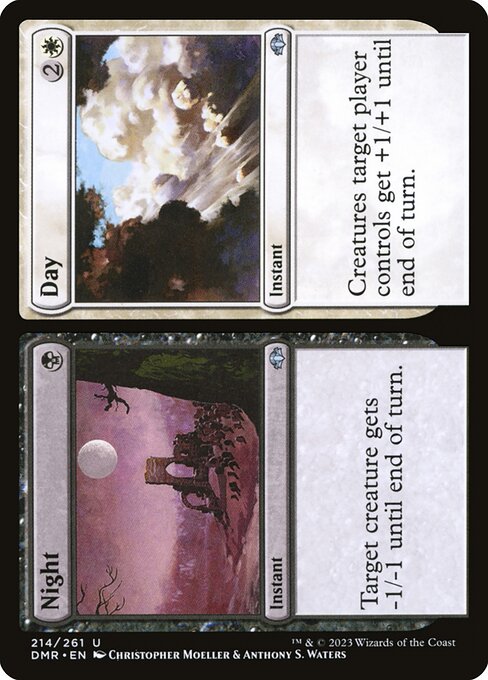
Image courtesy of Scryfall.com
Power, Tempo, and the Night/Day Dichotomy
Modern MTG hinges on a constant balancing act between mana efficiency, board presence, and tempo. Night // Day, a split card from Dominaria Remastered, is a compact classroom in those principles. With Night priced at {B} and Day at {2}{W}, the two faces give you a choice: disruptive control on a single target or broad acceleration for your board. The dual-color framing—black for Night and white for Day—pays tribute to the eternal cycle of shadows and light that colors Dominaria's history. 🧙♂️🔥💎
What the two faces actually do
- Night — Instant, {B}. Target creature gets −1/−1 until end of turn. This is a small but sharp nudge that can swing combats, disrupt blockers, or finish off a stubborn threat when you need a little edge in a single moment.
- Day — Instant, {2}{W}. Creatures target player controls get +1/+1 until end of turn. A broad, inclusive boost that can turn your entire side of the board into a sudden, pushy alpha strike—especially potent when you’ve got a swarm of tokens or a supportive creature lineup.
Notice how the card’s two faces aren’t just different in color and cost; they represent opposite sides of the same coin. When you plan a turn with Night // Day, you’re weighing tempo against wide efficiency. And because the Day effect can buff all creatures you control, it becomes a study in cumulative value—one that shines brightest when you’re deploying multiple threats or planning a multi-faceted attack. 🎲🎨
Understanding P/T ratios in this context
Power and toughness aren’t just about raw numbers; they’re about what those numbers cost you to adjust, and how long those adjustments last. Night’s −1/−1 for the cost of a single black mana is a tidy tempo play. It’s especially potent when you’re targeting an opponent’s bigger threat that would otherwise swing the race in their favor. Day, by contrast, costs more mana but provides a broader payoff: a +1/+1 boost to all of your creatures for a turn. On a per-mana basis, those two faces illuminate two halves of a classic MTG risk-reward curve.
Here are a few mental-math scenarios to anchor the idea:
- Single big threat trade: You attack with a 3/3, and your opponent blocks with a 2/3. Casting Night on their 3/3 before they declare blockers reduces their stomper to 2/2, potentially opening a path for your attack or saving you from a lethal swing. That’s a clean −1/−1 swap for 1 mana.
- Board-wide tempo swing: You control two 2/2 creatures. Casting Day on yourself pumps them to 3/3s for a turn, turning a potential stagnation into a decisive attack. You’ve just converted 2 power and 2 toughness into 4 points of pressure for 3 total mana (two mana for Day plus any needed timing and taps).
- Stacking nuance: If Night targets a creature that later gets Day buffed on the same turn (via Day cast targeting you), the creature’s net stats can end up at its original line or even better—depending on order and timing. Remember, Night affects only one creature; Day affects all creatures you control, so target selection and timing matter a lot for every swing.
These micro-interactions illustrate a broader truth about P/T ratios: the value of a spell isn’t just the numbers printed in big font. It’s how those numbers interact with what you already have on board, what your opponent can do in response, and how long the effect persists. Night // Day is a micro-lab for that experiment, especially when you start layering other influences—boosts from anthem effects, creatures with enter-the-battlefield triggers, or cheap removal that buys you a turn to set up the next phase of combat. 🧙♂️⚔️
Flavor, design, and the Dominaria Remastered perspective
Dominaria Remastered (DMR) revisits classic cards with a modern clarity, and Night // Day is a perfect fit for this treatment. The two faces carry distinct vibes—the nocturnal whisper of Night with its black mana bite, and the radiant, almost courtroom-like Day that borrows from white’s aura of communal protection. The card art is a collaboration between Christopher Moeller (Night) and Anthony S. Waters (Day), and you can feel the contrast in the illustrations as much as in the mechanics. The split-card concept itself is a flavorful nod to the way Dominaria’s lore often dwells in cycles and dualities, where night and day, shadow and light, can flip a board state in a heartbeat. 🎨💎
From a collector’s angle, Night // Day is an uncommon reprint in DM R that also commemorates the evolving design language of split cards. Its rarity, the dual-color identity, and its artwork”s pedigree make it a neat pick for players who like to track not just their win-loss records but the art and history of MTG as well. If you’re drafting a list that leans into pacing and tempo, this card is a reliable reminder that sometimes a single point of stats—added or removed—can shape a match just as decisively as a big bomb or a sweeping wipe. 🔥
Practical drafting and deck-building tips
- Pair Night with situational removals and other tempo plays to maximize value on a single target while preserving your own board’s momentum.
- Use Day when you’ve built a board with multiple creatures or when you expect a defensive block next turn. The mass buff can turn a swarm into a lethal alpha strike.
- Be mindful of your target choices for Day. If you control the opponent’s board briefly, the buff becomes a potential swing factor. Timing is everything.
As you experiment with these ideas, you’ll start to see how small P/T increments add up in the right contexts. Night // Day isn’t about brute force; it’s about tempo, choice, and the elegant dance between the dark and the light. And yes, it’s as satisfying as finding a perfect synergy in a long, coffee-fueled drafting session. 🧙♂️🔥⚔️